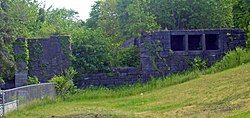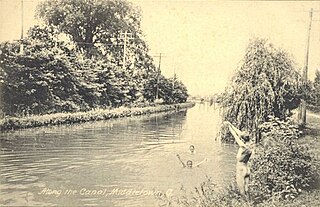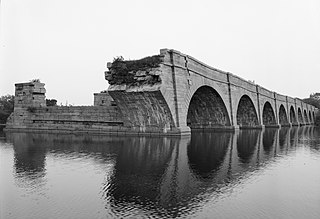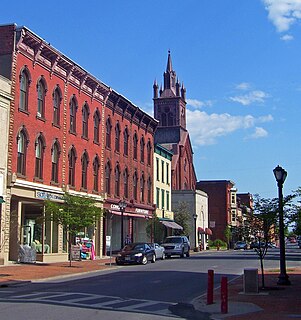Lock 18 of Enlarged Erie Canal | |
West end of lock, 2008 | |
| Location | Cohoes, NY |
|---|---|
| Coordinates | 42°47′05″N73°42′41″W / 42.78472°N 73.71139°W Coordinates: 42°47′05″N73°42′41″W / 42.78472°N 73.71139°W |
| Built | 1837-1842 [1] |
| Architect | Holmes Hutchinson |
| NRHP reference # | 71000526 |
| Added to NRHP | 1971 |
Lock 18 of the Enlarged Erie Canal is located off North Mohawk Street in Cohoes, New York, United States. It is made of stone blocks 3 by 2 by 1.5 feet (90 by 50 by 40 cm) in size, roughly 150 feet (46 m) in length, laid in a random ashlar pattern. The lock's wooden gates are no longer extant.

Cohoes is an incorporated city located in the northeast corner of Albany County in the U.S. state of New York. It is called the "Spindle City" because of the importance of textile manufacturing to its growth in the 19th century. The city's factories processed cotton from the Deep South, produced on plantations in the slave states.

New York is a state in the Northeastern United States. New York was one of the original thirteen colonies that formed the United States. With an estimated 19.54 million residents in 2018, it is the fourth most populous state. To distinguish the state from the city with the same name, it is sometimes called New York State.

The United States of America (USA), commonly known as the United States or America, is a country comprising 50 states, a federal district, five major self-governing territories, and various possessions. At 3.8 million square miles, the United States is the world's third or fourth largest country by total area and is slightly smaller than the entire continent of Europe's 3.9 million square miles. With a population of over 327 million people, the U.S. is the third most populous country. The capital is Washington, D.C., and the largest city by population is New York City. Forty-eight states and the capital's federal district are contiguous in North America between Canada and Mexico. The State of Alaska is in the northwest corner of North America, bordered by Canada to the east and across the Bering Strait from Russia to the west. The State of Hawaii is an archipelago in the mid-Pacific Ocean. The U.S. territories are scattered about the Pacific Ocean and the Caribbean Sea, stretching across nine official time zones. The extremely diverse geography, climate, and wildlife of the United States make it one of the world's 17 megadiverse countries.
The lock was built as part of an 1837-1842 plan to make the canal bed larger, heading off competition from railroads, and allowing a detour around the section of canal between Albany and Schenectady to the south, which had fewer locks and was difficult to navigate. Holmes Hutchinson, a canal engineer who later became chief of that department and a director of several railroads, surveyed the route and drew up the plans for all locks in the mid-1830s. [1] The canal was relocated slightly within the city of Cohoes; North Mohawk Street today parallels the original alignment, with sections of the original canal kept open to provide water power to nearby mill complexes along the Mohawk River. [2]

The Erie Canal is a canal in New York, United States that is part of the east–west, cross-state route of the New York State Canal System. Originally, it ran 363 miles (584 km) from where Albany meets the Hudson River to where Buffalo meets Lake Erie. It was built to create a navigable water route from New York City and the Atlantic Ocean to the Great Lakes. When completed in 1825, it was the second longest canal in the world and greatly affected the development and economy of New York, New York City, and the United States.
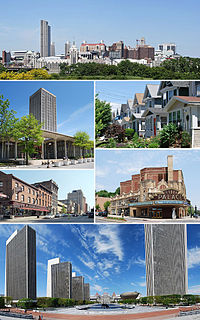
Albany is the capital of the U.S. state of New York and the seat of Albany County. Albany is located on the west bank of the Hudson River approximately 10 miles (16 km) south of its confluence with the Mohawk River and approximately 135 miles (220 km) north of New York City.
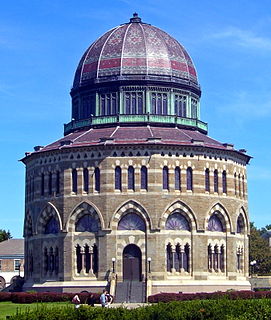
Schenectady is a city in Schenectady County, New York, United States, of which it is the county seat. As of the 2010 census, the city had a population of 66,135. The name "Schenectady" is derived from a Mohawk word, skahnéhtati, meaning "beyond the pines". Schenectady was founded on the south side of the Mohawk River by Dutch colonists in the 17th century, many from the Albany area. They were prohibited from the fur trade by the Albany monopoly, which kept its control after the English takeover in 1664. Residents of the new village developed farms on strip plots along the river.
Ten of the locks from the Enlarged Erie Canal remain within Cohoes. [3] Lock 18 was individually listed on the National Register of Historic Places, added in 1970 in recognition of the high quality of its remaining stonework; the remainder of the locks on city-owned land were added to the National Register in 2004 as a non-contiguous historic district. A city-owned trail along the former towpath allows visitors to see them. There is also a small parking lot along the street northeast of the lock with an interpretive sign.

The National Register of Historic Places (NRHP) is the United States federal government's official list of districts, sites, buildings, structures, and objects deemed worthy of preservation for their historical significance. A property listed in the National Register, or located within a National Register Historic District, may qualify for tax incentives derived from the total value of expenses incurred preserving the property.

A towpath is a road or trail on the bank of a river, canal, or other inland waterway. The purpose of a towpath is to allow a land vehicle, beasts of burden, or a team of human pullers to tow a boat, often a barge. This mode of transport was common where sailing was impractical due to tunnels and bridges, unfavourable winds, or the narrowness of the channel.
